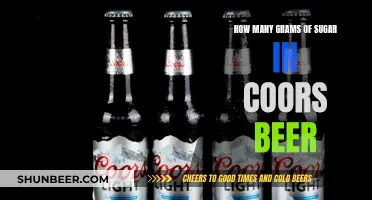
Beer is made from grains, spices, yeast, and water. While sugar is not added to the list of ingredients, it is necessary to produce alcohol. During the brewing process, the germination of grains breaks down stored starch into fermentable sugar, mainly maltose. The sugar is then fermented by yeast to produce alcohol. Therefore, sugar is a key element in beer brewing, but it is not added as an ingredient and is instead produced during the germination of the grains. While beer may not contain much sugar, it is an alcoholic drink that can lower blood sugar levels.
| Characteristics | Values |
|---|---|
| Does beer contain sugar? | Beer contains very little sugar, but it does contain carbohydrates, which can raise your blood sugar. |
| Does beer break down into sugar? | Beer does not break down into sugar. |
| Does beer affect blood sugar? | Beer can lower your blood sugar levels. |
What You'll Learn

Beer contains little sugar but is high in carbohydrates
Beer generally contains very little sugar, but it is high in carbohydrates, which can raise your blood sugar levels. The sugar content of beer is derived from the processing of grains, which is then fermented by yeast to produce alcohol. This means that the final sugar content of beer is quite low, as the yeast ferments most of the sugar.
The sugar content of beer varies depending on the type of beer and the ingredients used. For example, non-alcoholic beers have the highest sugar content, as none of the sugar is converted into alcohol. Light beers tend to have slightly more sugar than regular beers due to differences in their fermentation process. Additionally, some beers may have added ingredients such as honey and corn syrup, which can increase their sugar content.
While beer may not have a significant amount of sugar, it is an alcoholic drink, and as such, it can lower your blood sugar levels. Alcohol impairs the body's ability to produce and break down stored sugar, leading to potential hypoglycaemia or low blood sugar levels. This is why it is generally recommended to consume alcohol with a meal that contains carbohydrates.
Furthermore, beer is a significant source of calories. Alcohol contributes more to the calorie content of beer than carbohydrates. Therefore, when considering the impact of beer on weight and health, it is essential to focus on its calorie content rather than solely its carbohydrate or sugar content.
It is worth noting that serving facts on alcohol labelling are not mandatory, and manufacturers are not required to disclose the amount of sugar or carbohydrates in their products. This makes it challenging for consumers to determine the exact sugar and carbohydrate content of their favourite beers. However, according to a review by brewing expert Charles Bamforth, most beers on the market contain relatively low levels of carbohydrates.
Beer and Blood Sugar: How Three Beers Affect You
You may want to see also

Alcohol is processed by the liver and classified as a toxin
Alcohol is a toxin, and the body gives it metabolic preference, meaning it is broken down before other foods and drinks. The liver can process, on average, a standard drink per hour. If alcohol is consumed in excess of this, the liver can't keep up, and the alcohol starts to circulate through the body without being broken down.
Alcohol is a toxic, psychoactive, and dependence-producing substance. It has been classified as a Group 1 carcinogen by the International Agency for Research on Cancer, decades ago. This is the highest-risk group, which also includes asbestos, radiation, and tobacco. Alcohol is the leading risk factor for death among males aged 15-59, particularly in Eastern Europe.
Alcohol is highly diffusible through cell membranes and is metabolised by most tissues. However, the liver is the primary site of alcohol metabolism and is, therefore, one of the major targets for alcohol-induced organ damage. Alcoholic liver diseases include steatosis, different subtypes of steatohepatitis, cirrhosis, and hepatocellular carcinoma. Cirrhosis of the liver is the third leading cause of alcohol-attributable deaths worldwide, accounting for 16.6% of such deaths.
Alcohol does not turn into sugar in the body. In fact, it tends to lower blood sugar levels. Alcohol acts more like fat in the body than sugar. The storage form for alcohol is triglycerides, which is another name for fat.
Alcohol is broken down into acetaldehyde, which is a toxic by-product and known carcinogen. When the body breaks down ethanol, it produces acetaldehyde, which damages DNA. This can lead to cancer as DNA is a molecule needed by nearly every cell in the body for information on how to function, repair, and regrow.
Sugar in Beer: How Many Grams?
You may want to see also

Alcohol lowers blood sugar levels
Alcohol does not turn into sugar in the body. In fact, it tends to lower blood sugar levels. This effect is well-documented, and people with diabetes are advised to adjust their insulin and oral medications if they consume alcoholic beverages.
When you drink alcohol, your liver needs to break it down. While this happens, your liver stops releasing glucose. As a result, your blood sugar level can drop quickly, putting you at risk of low blood sugar (hypoglycemia). This risk remains for hours after your last drink, and the more drinks you have, the higher the risk. This is why it is recommended to only drink alcohol with food and in moderation.
The symptoms of low blood sugar are very similar to the symptoms of alcohol intoxication, including slurred speech, drowsiness, confusion, and difficulty walking. This makes it difficult to tell the two conditions apart, and even more so if you have hypoglycemia unawareness, a condition in which you don't recognize that your blood sugar is low.
It's important to note that alcoholic drinks like beer and sweetened mixed drinks are high in carbohydrates, which can raise blood sugar levels. Additionally, alcohol has a lot of calories, which can lead to weight gain and make it harder to manage diabetes. Calories from alcohol are stored in the liver as fat, and liver fat can make liver cells more insulin-resistant, leading to higher blood sugar over time.
For people with diabetes, drinking alcohol can cause fluctuations in blood sugar levels, affect diabetes medications, and lead to other possible complications. It is crucial for individuals with diabetes to consult their healthcare provider to understand the risks and make informed decisions about alcohol consumption.
Dark Beer's Sweet Secret: More Sugar, More Flavor?
You may want to see also

Beer is made from grains, spices, yeast and water
Beer is made from four core ingredients: grains, hops, yeast, and water. The specific types and amounts of these ingredients, as well as the brewing techniques employed, determine the unique characteristics of each beer.
Grains, such as barley, wheat, rice, corn, oats, rye, and others, are the foundation of beer. The barley and wheat grains undergo a malting process, where they are soaked in water, germinated, and then dried in a kiln. This process metabolizes the natural grain sugars, known as maltose, which serves as food for the yeast during fermentation. The grains contribute to the malt flavor, aroma, color, and fermentable material in the beer.
Hops are the flowers of a perennial vine and are responsible for imparting bitterness, flavor, and aroma to the beer. The alpha acid in hops gives beer its distinctive bitterness, while the oils contribute to the floral, citrusy, and hoppy aromas. Hops also possess antimicrobial properties, acting as a natural preservative and stabilizing agent.
Yeast is a crucial microorganism in the beer-making process. It feeds on the sugars derived from the malted grains and converts them into alcohol and carbon dioxide through fermentation. There are two main categories of brewing yeast: ale yeast and lager yeast, each producing distinct flavors and characteristics in the final product.
Water, the most abundant ingredient in beer, comprising up to 95% of its weight, is essential for the brewing process. The quality and mineral content of the water can significantly impact the taste of the beer. Different regions are known for their unique water profiles, influencing the development of specific beer styles.
While beer is primarily crafted from these four core ingredients, brewers may also add other additives, such as fruit, sugar, and spices, to adjust the flavor and create endless variations. The combination of these ingredients and the brewer's techniques result in the diverse array of beers available today.
Abita Beer: Sugar Content and Nutritional Facts
You may want to see also

Non-alcoholic beers have the highest sugar content
It's a common misconception that alcohol turns into sugar in the body. In fact, according to nutritionist Joy Bauer MS, RD, CDN, it is impossible for alcohol to turn into sugar in the body. However, this doesn't mean that alcohol and sugar are unrelated. Sugar is necessary for producing alcohol and is, therefore, an essential element in the beer-making process.
Beer is generally made from grains, spices, yeast, and water. Barley and wheat are the most commonly used grains, while hops are the principal flavoring spice. During the malting process, the grain germinates, breaking down stored starch into fermentable sugar, mainly maltose. The next step, mashing, involves roasting, milling, and soaking the grains in hot water, resulting in a sugar-containing liquid called wort. Hops or other spices are added during the boiling step, and then yeast is added to the wort during fermentation, converting sugars into alcohol and carbon dioxide.
Since sugar is converted into alcohol during fermentation, regular beers tend to have very low sugar content. However, non-alcoholic beers are an exception to this rule. Because the alcohol is removed from non-alcoholic beers, they often have a less appealing taste, so sugar is added back in. On average, non-alcoholic beer can contain up to 8 grams of sugar per 100ml, which is more than twice the amount found in regular beer. For example, Coors Light contains 1 gram of sugar per 355ml serving, while its non-alcoholic counterpart has 8 grams of sugar for the same serving size.
It's important to note that the sugar content can vary among different non-alcoholic beers, and some may have less sugar than others. For instance, Heineken 0.0 and Athletic Brewing Company's non-alcoholic beers have been found to have lower sugar content compared to other brands. Additionally, non-alcoholic beers generally have fewer calories than regular beers, so they can still be a healthier alternative, especially for those looking to reduce their alcohol intake.
While non-alcoholic beers may have higher sugar content, it's worth mentioning that regular beers are not entirely sugar-free. Light beers, for instance, tend to have slightly more sugar, and regular beers are still a source of carbohydrates, which can affect blood sugar levels. Furthermore, alcoholic beverages can lower blood sugar levels, and cocktails made with sugary mixers can also significantly impact blood sugar. Therefore, it's always important to consume alcohol in moderation and be mindful of the sugar content, especially for those with health conditions like diabetes.
Best Low-Sugar Beers: The Sweetness Spectrum
You may want to see also
Frequently asked questions
No, beer does not break down into sugar. In fact, beer and other alcoholic drinks have the opposite effect on blood sugar, causing it to drop.
While beer is not high in sugar, it does contain carbohydrates, which can raise your blood sugar. Beer is also a significant source of calories.
Alcoholic drinks can lower your blood sugar levels, so people with diabetes may need to adjust their insulin and oral medications if they drink beer or other alcoholic beverages. However, this advice only refers to straight liquor and wine. Cocktails made with sugary mixers are another story.







